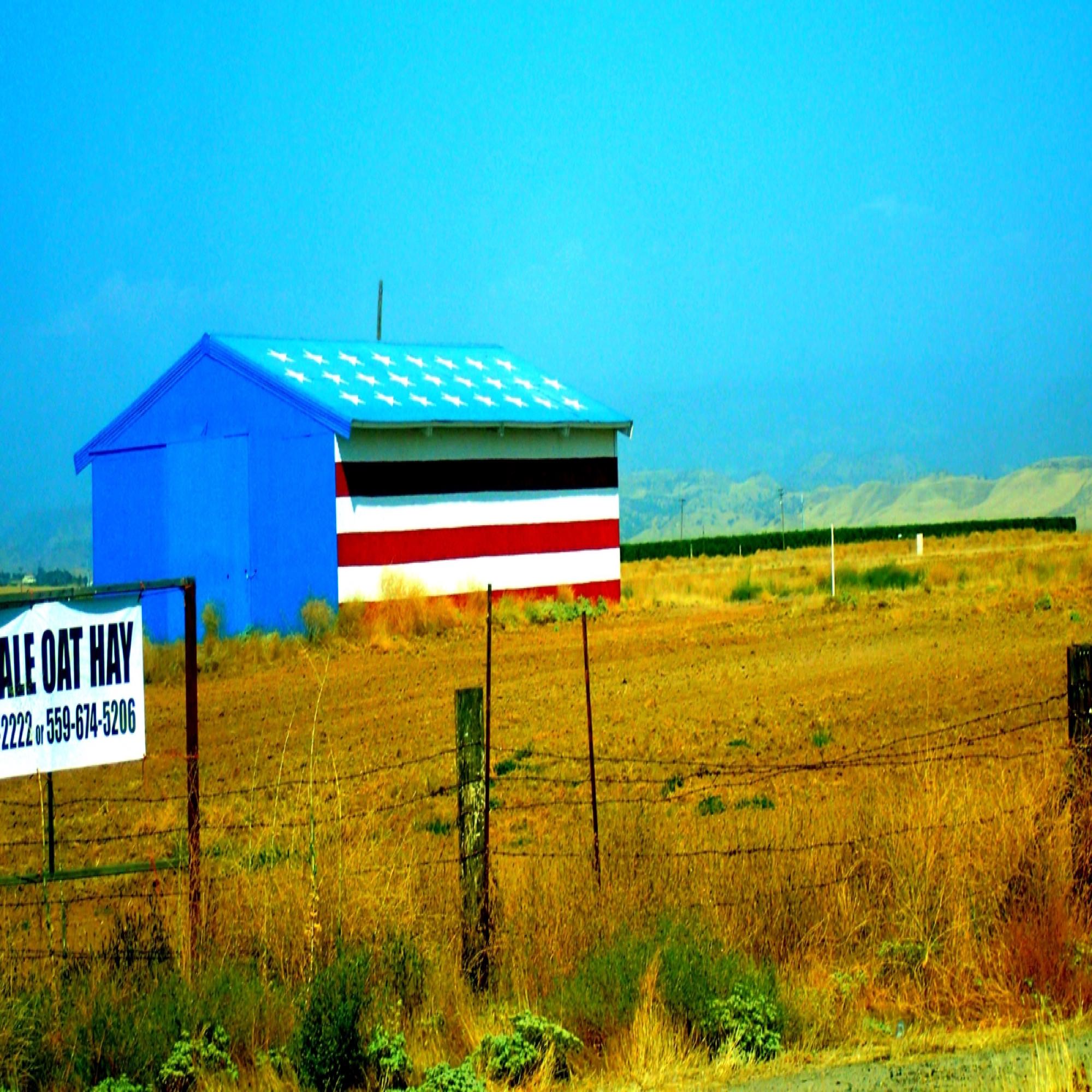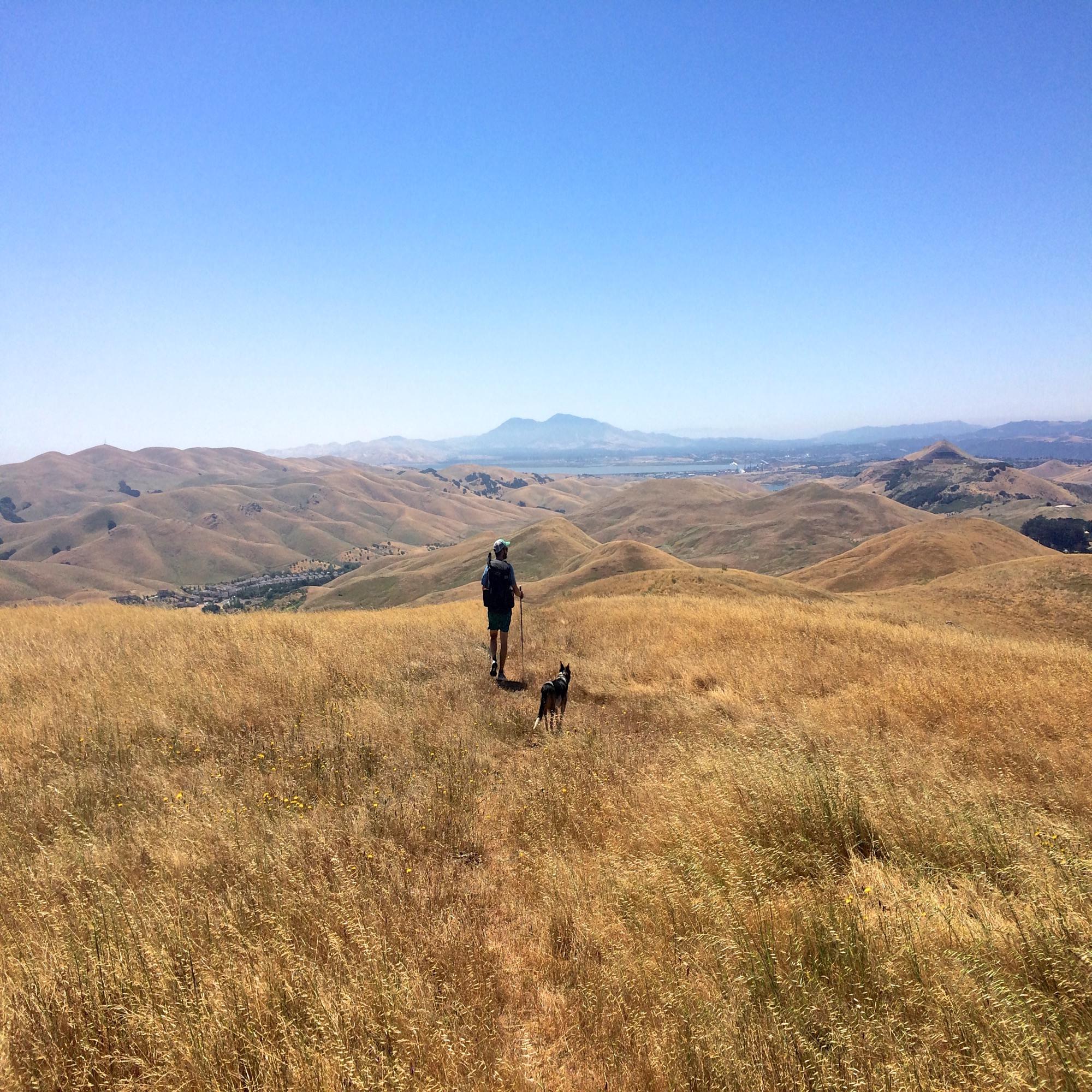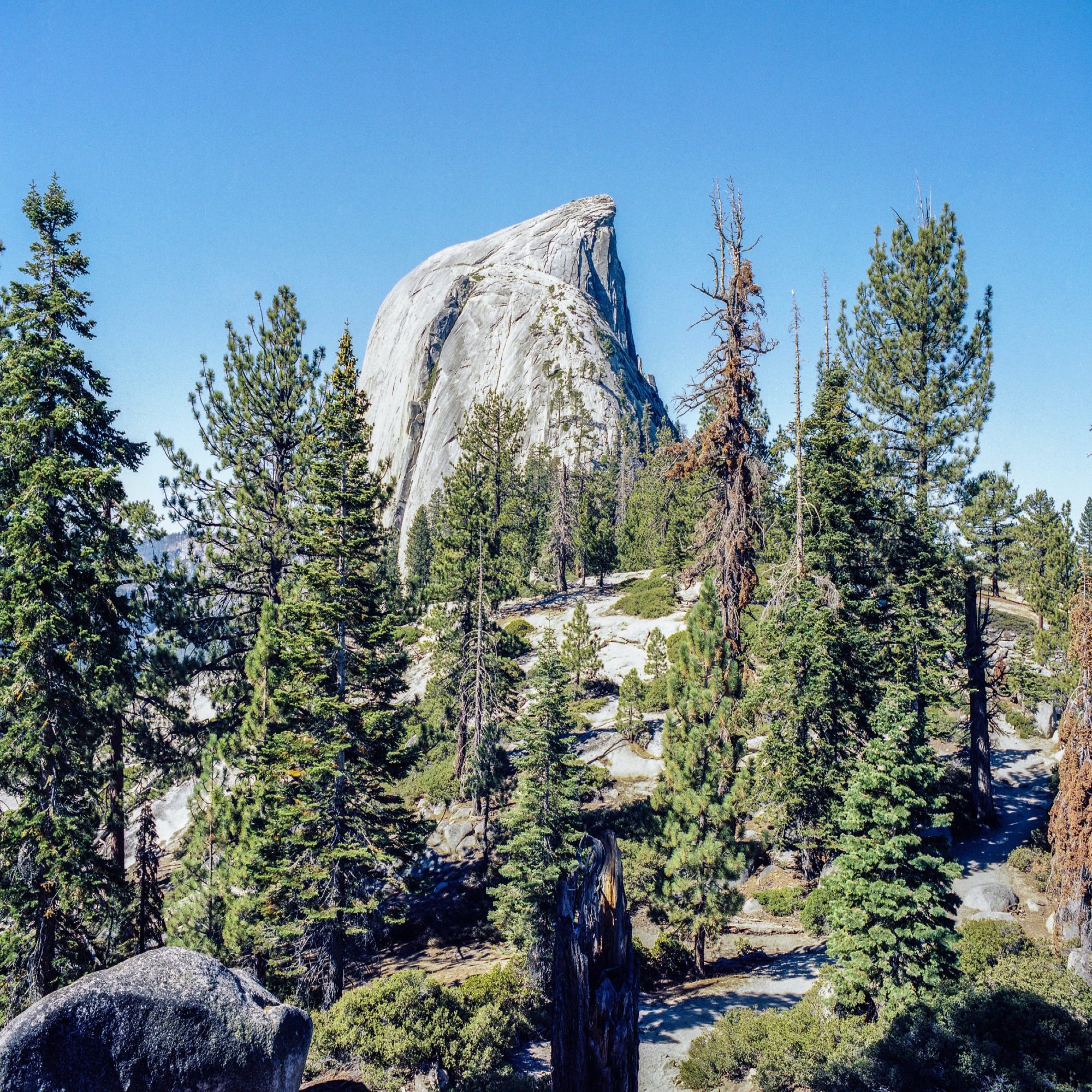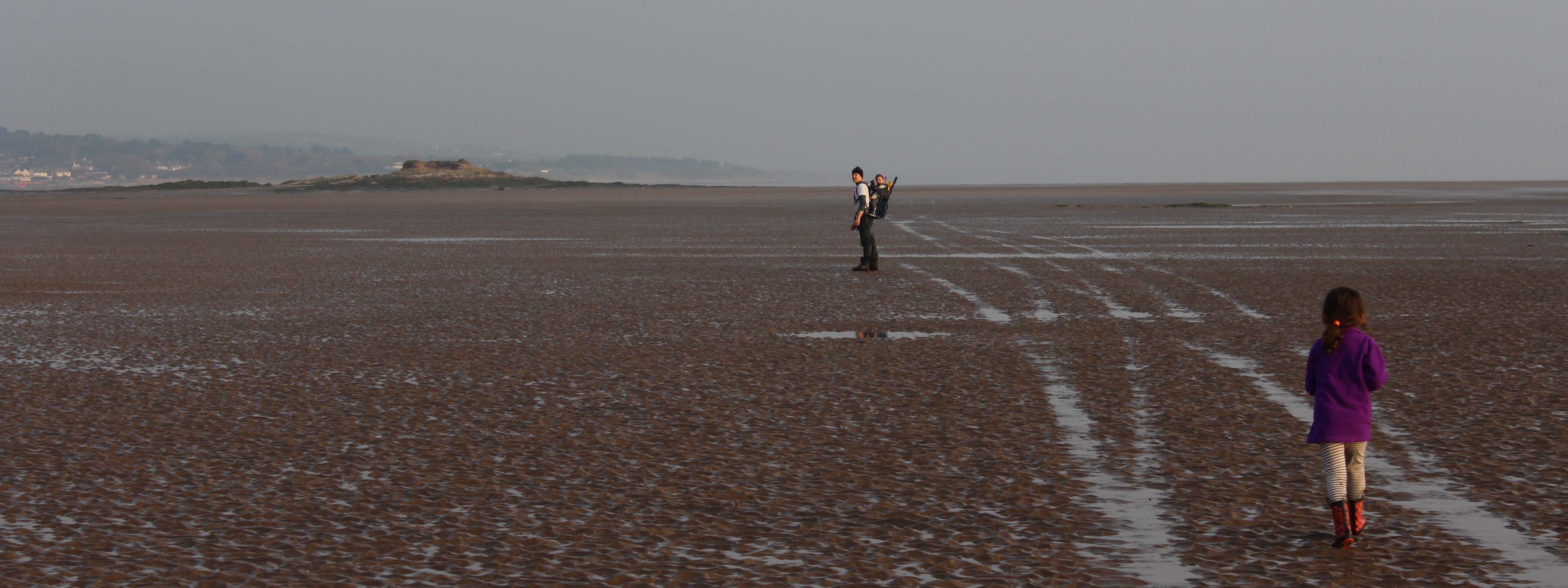Does a bear *** in the woods?
Matt Heason recounts his family’s trip to Yosemite, with the added bonus of a trip up Half Dome and a memorable encounter with a ‘bear’.
Summer in the high Sierras in recent years has delivered virtually no rain, and the usual snowy winters have been less severe than usual resulting in less meltwater*. That's well and good for residents and visitors, who can ration what water there is, but the permanent residents, in particular the vegetation, are suffering.
Suffering is probably the wrong word – collective forests are suffering – individual trees are dying, in their tens of thousands. The seriousness of the drought is highlighted by an informative display in a visitor centre in Sequoia National Park that explains the importance of natural forest fires to the ecosystem. These trees, some of them thousands of years old, have evolved to withstand the harshest of conditions. The results of this super-dry spell are evident in large swathes of yellow forest, especially at lower elevations.
I learn most of this while talking to a softly spoken, tall Canadian in the queue for the toilets at a well-managed campsite in Tuolomne Meadows. It's one of my favourite places on our planet. Our tent is pitched underneath a mature pine tree, distinctive for a series of parallel scars running vertically down the trunk. We try to come up with benign explanations, but reluctantly come to the conclusion that the only possible cause is a big bear sharpening his claws. We are in Tuolomne as it's a sneaky way to get a toe into Yosemite National Park without any pre-booked accommodation. We rarely pre-book accommodation wherever we are. It takes away the spontaneity of travel, forcing a fixed agenda and stopping you from reacting to chance conversations with strangers who are more often than not keen to share their favourite places with you if you delve. Tuolomne is not actually in Yosemite Valley itself so it has plenty of space left for us. While it may be less grand, it is equally beautiful, far less busy, and has the summer benefit of being higher, with comfortably cooler temperatures. Crucially for us, it's a mere 20 miles as the crow flies from the heart of the valley, ground zero for any self-respecting climber, sadly locked down at this time of year by those who do choose to travel on a fixed itinerary and tick off one of the true natural wonders of the world.
Lembert Dome
Rising out of the (healthy) forest we are camped in, like a mathematical bell curve, is Lembert Dome, the first of many examples of the granite monoliths that make the area so famous. We pack a small day sack and lace up our shoes tightly. Leaving the car park, we turn abruptly away from the path and the groups of walkers taking the longer path around the back of the dome and onto its summit, to tread up the easy angled lower slabs on the front face. The surface is rough and as sticky as fly-paper. As the angle steepens it's tempting to keep on going straight up, but that would be unwise. It was clear from the campsite that the upper slopes are just too steep for comfort without ropes. We continue up, traversing right via ledges and stumps of old pines, a family of ants on a smooth white boulder.
Shortly below the summit we get a glimpse to the north where the sky has turned a livid purple-grey. Hairs rise on the back of my neck. An electrical storm up here with no protection would be seriously bad news.
We retreat, quickly sliding down to the tree line and back to the tent before the rain.
It doesn't come so I squeeze the most out of the day with a truly amazing 6-mile run to Glen Aulin High Sierra Camp. It’s the end of the day so there are no other walkers; just me, the river, the trees and whatever is in the trees! I stop for a dip in Tuolomne River above the falls at Cold Canyon and snap a selfie. The run back ends in darkness without a torch, senses heightened by the prospect of an encounter with a bear. That evening we join other campers around a fire to listen to a ranger talk of her climbing adventures in the Valley. The boys are intrigued. For Soph and I it's the real-life embodiment of many hours spent reading books and magazines on this Mecca for the climbers of the world.
The real reason for starting our Yosemite trip at Tuolomne is to secure wilderness permits for a three-day walk down into the valley proper. We're literally overjoyed to be offered extra permits to scale the ladders up Half Dome as a bonus (despite the fact that these are sold out months in advance a few are kept back for those on multi-day trips). So we spend a day packing and sorting food and kit before heading out from the southern end of the picture-postcard Tenaya Lake after tea. It's a 2-hour walk uphill to Sunrise Lakes where we make our first camp. There are a few other tents there, but we find a secluded spot on a granite slab above the lake. Darkness falls fast so we swim without sight and dry naked in front of a roaring fire. There are marshmallows before bed.
As we hit the trail the next morning we're rooted to the spot as a coyote stops just feet from us and assesses the situation for a few seconds before silently disappearing into the forest. It's a magical moment and keeps us quiet and alert for the rest of the morning.
The mercury slowly rises and we welcome any water by the path. Filling our bottles and filtering as we go, wetting sun hats and swimming. Although there are a few other walkers out it feels very remote now, hours from any road or phone. We walk through burned out areas of forest, the armour-plated bark of these magnificent trees blackened, but still intact, protecting what's inside – exactly as described in the visitor centres. After 10 hours on the go we arrive at our destination for the night, a small camp spot by a stream below the upper cliffs of Half Dome.
Half Dome
To walk up Half Dome from the valley floor – the usual route – is a 12-hour return trip, probably more for us with kids. This camp is two hours from the summit. We arrive at 7pm and weigh up our options. We decide to pitch camp, eat and head up tonight. That way we'll get cooler weather, we'll get there to see the sun go down, and we'll more than likely not see anybody else. To leave in the morning will mean hotter weather and hundreds of people. As we emerge from the trees to the bottom of the infamous ladders we meet two rangers heading down. They spend the day there checking permits. They check ours and let us know that there is nobody else on the mountain above us. They smile as the boys run off, clearly pleased to see youngsters enjoying the place. The summit of Half Dome is accessed either by climbing up its famous vertical face or by using a set of ‘ladders’ on the convex slabs on the back side. These slabs are too steep to simply walk up, so the park service have installed a regular series of metal poles that simply slot into holes drilled in the rock.
Suspended between these poles is a metal cable, and resting on the rock against the poles are wooden rungs that act as steps. It is very rudimentary and not for the faint hearted. It's around a 150 metres from bottom to top, and reputedly people do actually fall from time to time. I'm glad that we are alone. I have a long sling, which I tie around Dylan's waist and wrap around my hand. I'm confident he won't fall, but want to give him (and Soph) the security of knowing that if he were to do so, he'd be safe. Bryn scampers away like a blond headed gecko! It takes us 20 minutes to scale them, the pace quickening as the angle eases towards the summit. We arrive on top for the last few minutes of the sun, surprised to see two sun-bleached Californian 'dudes' topping out on one of the climbing routes amid lots of hollering and whooping. They’ve been on the wall for three days. The boys are quite genuinely impressed! We can’t linger as darkness is on its way. We need to get back at least to the ranger’s cabin with some natural light. The zigzags down through the forest from there are navigable by torch.
As we arrive back into camp we're stopped in our tracks by a movement in the shadows. We're dog-tired, but immediately our senses are on high alert - a couple of hours ago we passed a ranger with a paint gun she'd been using to mark bears in an attempt to track the troublesome ones. The shadow moves. It's bear sized and moving. Slowly. First away from us, and then towards us as it rises up. "Hey, bear," we all shout, keen to let it know that we are here and we don't want it to be here. It ducks back down, but instead of moving away from us it heads towards a nearby tent (not ours, fortunately). Louder calls of "Hey, bear" "Go away bear". We've been walking using natural night vision so now scramble to get out the torches and make our presence known. As we shine the light the shape disappears inside the tent, zipping the porch up as it goes! Daft German tourist we’d met earlier when we pitched our tent taking a dump in the woods not 10 metres away from their own (and our!) tent. Bad form. But we did laugh. A lot!
It’s a lazy start to the next day before heading down into the valley against the flow of day trippers. It's a spectacular trail; rocky and uncompromising, steep and beautiful, down past a series of emerald pools and thundering waterfalls. We ignored the no swimming signs. Down in the valley there's another perk to being a walker: access to the walk-in campground with guaranteed space. It's thoughtfully tucked away from the crowds in yet another beautiful grove of tall trees next to a swimming hole. There's no light, but there are toilets, a tap and bear boxes for your food and smellies. We made camp, rinsed off three days of dirt and sweat and hit the main drag – pizzas, cold beers and ice cream – with the masses.
Tenaya Lake
Early doors the following day I snuck out of the tent and tip toed barefoot across the dust and pine needles to the access road, stuck out my thumb and prepared to wait a while for a lift out of the valley. I waited less than a minute for the first car to pick me up and drop me back at Tenaya Lake – 7 miles as the crow flies, over 40 by car! That drive, before the tourist traffic and the heat of the day had taken hold, was magical.
A dip in Tenaya Lake, alone with my thoughts in the most striking of craggy landscapes, filled me with an energy I've rarely experienced before.
I know that in 20 years’ time I'll still be able to channel that feeling and it'll lift my spirits to know that the place exists, and that one day I'll go back.
That trip in Yosemite was but a short part of our three-week tour, based in San Francisco in August 2016. We had desperate trouble getting there all together. Soph, born in Iran at a missionary hospital, was denied entry and spent a stressful week in London battling red tape and bureaucracy before joining us in Reno. The boys and I were hosted royally by friends in Silicon Valley while we had our own battles with Turo, an AirBnB-style car rental platform that initially let us down, but then delivered with bells on in the form of a Landrover Discovery.
We toured Stamford University on bikes, watched pelicans swoop for fish by a remote waterfall on the beach, snapped a couple proposing on Cannery Row and ate shrimp at Bubba Gump's. We swam every day, SUP'd with crayfish, got bombed by scary-big seagulls and caught wild terrapins in underwater caves. More friends showed us the wilder side of Reno, where we were snapped by a drone while bathing at hot springs, and trekked in thunderstorms in the little known, but majestic Green Mountains. We downed tequilas and ate hot dogs, we ran among the redwood groves of Sequoia and went out of our way to find iconic swimming holes like Candy Rock, Natural Bridges and Cathedral Beach. We stopped at a liquor store in a neighbourhood we shouldn't have stopped in and rented a log cabin in the woods. We star gazed and BBQd. We met Americans of every shape, size and colour, and do you know what? Every one of them was nice as pie and, at the time, couldn’t conceive of a certain Mr Trump running the show.
It was with sadness that we left California. We'd gone with trepidation, knowing that the scenery was the best, but worried that we'd fall foul of jobsworths, rules and regulations. In the event we found a very well-run system that protects the natural environment above all else. By traveling at the tail end of the season we dodged the crowds and never once felt frustration.
*That initial paragraph was written on returning from Yosemite in September 2016. Ironically, but thankfully, the following winter months delivered record snowfall, which then resulted in record snowpack lying well into the winter months. Large parts of the high country were off limits to hikers as the snow-melt continued long into the summer, swelling rivers and closing bridges.












